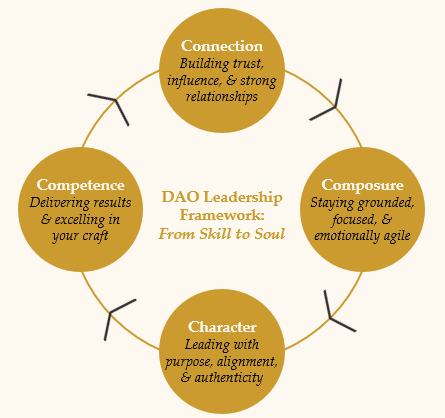
From Skill to Soul: DAO’s Leadership Framework
Explore the four pillars of leadership - Competence, Connection, Composure, and Character - and what it takes for high-achieving professionals and organizations to grow and lead with a steady inside and strong outside.
Sandra William
7/16/20254 min read
Life would be easier if career success were just about technical competence. But the hard reality is, the professionals who truly rise - those who lead through complexity, inspire others, and sustain impact - are the ones who develop a deeper set of inner and relational capacities. They know how to navigate ambiguity, connect with others, regulate themselves under pressure, and make decisions grounded in values, not just metrics.
These aren't “soft skills,” they are essential skills. And without them, even the most competent high achievers can stall, burn out, or lead in ways that are effective on paper but unsustainable in practice.
We refer to this evolution as an expansion from “Skill to Soul”, adding to technical skill the inner capacities needed to lead oneself and others with clarity, purpose, and effective impact.
Whether you're an individual seeking to grow or an organization investing in leadership capability, understanding the four foundational pillars - Competence, Connection, Composure, and Character - can help identify where leadership development is needed and untapped potential lies.
The Four Pillars of DAO’s Leadership Framework
1. Competence
Delivering results and excelling in your craft
Competence is the starting point of most professional journeys and remains critical during major transitions, especially when your role is expanding or your career is shifting. It includes technical expertise, critical thinking, and the ability to produce high-quality outcomes. It builds trust and credibility early on, but while competence gets you in the room, it won’t take you all the way through it.
Signposts to invest in competence:
Transitioning into a new role, industry, or level of responsibility
Seeking to deepen or broaden subject matter expertise
Aiming to become known as a go-to, high-quality contributor
Struggling to meet expectations in a more complex or ambiguous environment
Receiving feedback about lack of follow-through, detail, or execution
2. Connection
Building trust, influence, and strong relationships
As professionals grow, their success becomes increasingly tied to how well they work with others and not just what they deliver on their own. Connection becomes especially important when moving into leadership roles, managing stakeholders, or collaborating across functions and cultures. It includes emotional intelligence, presence, and the ability to inspire trust and alignment across people.
Signposts to invest in connection:
Stepping into people management or cross-functional collaboration
Looking to expand influence across teams, functions, or clients
Wanting to strengthen relationships and build trust more intentionally
Facing misalignment, friction, or misunderstandings in key relationships
Receiving feedback about communication style, listening, or interpersonal dynamics
3. Composure
Staying grounded, focused, and emotionally agile
Composure becomes essential when the pace picks up, the stakes get higher, or the context becomes more uncertain. It’s the ability to stay centered under pressure, manage emotional responses, and recover clarity in moments of stress or ambiguity. Professionals often realize the need for this pillar as they take on more visibility, responsibility, or face emotionally charged dynamics.
Signposts to invest in composure:
Taking on a high-pressure or high-visibility role
Seeking to show up with more presence, calm, or clarity
Wanting to regulate reactions and maintain focus under stress
Noticing burnout, overwhelm, or persistent emotional triggers
Receiving feedback about reactivity, defensiveness, or lack of grounded-ness
4. Character
Leading with purpose, alignment, and authenticity
Character is the inner compass that guides meaningful leadership. It’s about clarity of purpose, commitment to values, and the courage to lead authentically, not just perform effectively. This pillar becomes especially important during transitions, big decisions, or moments when your work no longer aligns with who you are.
Many professionals reflect on character later in their careers once they’ve earned credibility and leverage. But those who invest in it early tend to make more intentional choices from the start and avoid burnout, disillusionment, or misaligned paths down the line.
Signposts to invest in character:
Reaching a stage where meaning and purpose matter more deeply
Wanting to define success on your own terms, not others’ expectations
Facing value tensions or ethical dilemmas in your role
Feeling disconnected from your work, identity, or long-term vision
Recognizing a gap between your external impact and internal alignment


What It Takes to Build the Four Pillars
Competence
Competence is strengthened through challenge and iteration. Taking on stretch assignments, engaging in targeted learning or training programs, and receiving timely feedback all help sharpen this pillar. But development doesn’t happen passively; it’s accelerated by environments where expectations are clear, learning is continuous, and feedback is part of the culture. When individuals and organizations align skill-building with emerging responsibilities, not just current performance, they create momentum that’s both credible and future-ready.
Connection
Connection deepens when individuals are supported to lead through people, not just tasks. Developing this pillar requires intentional practice in empathy, communication, and relational presence - skills that are built in real conversations, stakeholder dynamics, and moments of feedback. Organizations play a critical role by creating safe environments for collaboration, trust, and open dialogue. Relationship-building isn’t a soft skill; it’s a strategic one, and it flourishes where interpersonal growth is valued alongside performance.
Composure
Composure is cultivated through self-awareness and emotional agility, qualities that emerge not from removing stress, but from relating to it differently. Individuals build composure by learning to notice their internal patterns, pause under pressure, and restore clarity when things feel unclear. This is easier in cultures that normalize reflection, build in moments of pause, and support leaders to lead themselves before they lead others. When performance and presence are treated as interdependent, composure becomes a real strength, not a hidden struggle.
Character
Character takes shape when individuals align their choices with who they are, not just what’s expected of them. It’s built through values-driven decisions, purpose-centered reflection, and the willingness to define success on personal terms. But it’s also reinforced in environments where authenticity is encouraged. Organizations that invite purpose conversations, support identity exploration, and allow people to lead from within create cultures where character becomes a source of trust, direction, and meaningful impact.
Taking the first step
The development of these four pillars - Competence, Connection, Composure, and Character - is not reserved for a select few, nor is it a one-time effort. It’s a continuous process that most, if not all, high-achieving professionals encounter as they navigate new levels of responsibility, impact, or self-awareness.
The most important step is often the simplest: recognizing which pillar is asking for your attention right now. Whether it’s a sense of burnout, a struggle to influence, or a desire for more grounded leadership, each signal points to a growth opportunity.
For individuals, it means creating the space to pause and reflect. From there, build a plan to reinvest in areas that no longer feel automatic.
For organizations, it means creating environments and offering resources that support not just performance, but the deeper capacities that sustain it. This might look like training workshops, leadership retreats, a culture of positive feedback, mentorship programs, coaching opportunities, and ways of working that promote both individual and team growth
Because ultimately, leadership becomes less about status and more about how you show up: strong on the outside, steady on the inside.
Daring
Empowering hidden moon shooters to reach the moon
